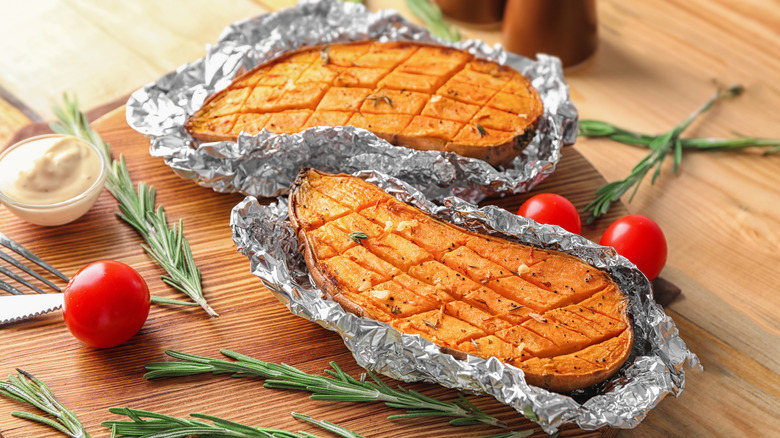A Little Water Can Tenderize Your Roasted Sweet Potatoes
There is nothing better than a baked sweet potato served steaming hot straight out of the oven. They really can't be beaten as far as warming comfort food goes. Roasting them whole can take some time until they are properly softened, but opting for a faster shortcut like the microwave just doesn't compare. There's even a scientific principle that proves this. Known as the Maillard reaction, it explains how oven roasting a potato (of any variety) converts its starches into natural sugars — a process that only occurs when the potatoes are slow-roasted. Microwaving or boiling does not allow this cellular-level caramelization to occur, so sweet potatoes simply won't taste as sweet.
The one problem with oven-roasting sweet potatoes is that they tend to turn out dry, both inside and out. The trick to achieving restaurant-quality, soft outer skin with moist, tenderized flesh is to wrap the tasty tubers in foil and add a little water before sealing them up. This method produces delectably fork-tender results every time. As the water heats up within the foil, it essentially steam-bakes the sweet potatoes from within, keeping them hydrated as they cook.
How to steam-bake sweet potatoes in your oven
Start by preheating your oven to 425 degrees Fahrenheit. Then, simply wrap washed sweet potatoes in aluminum foil — but before you close them up, pour in about four to five tablespoons of water directly onto the foil — then seal everything up tightly. Use more or less water depending on the size of the potato. You may also wish to line your pan with additional foil in case of spillage, and then place everything in the oven. The cooking time will depend on the size of the potatoes, as well as your oven, but give them at least an hour before checking for doneness; larger ones may take up to an hour and 25 minutes or more. They're done when a knife passes easily through the skin and the flesh can be mashed without much resistance.
Another method to achieve a similarly soft and tender result is by using a covered baking dish. Make a one-inch slit on the top of each sweet potato and place as many as will fit into the dish. Fill the dish with approximately ¼ inch of water so that the bottoms of the potatoes are sitting in a shallow pool of liquid. Cover with a lid or tightly sealed foil, then bake at 400 degrees Fahrenheit until they reach your desired softness. Serve these stuffed with your favorite toppings or mash them up as a delicious side dish.
Velvety soft potatoes, roasted to perfection
These water-kissed sweet potatoes turn out light and creamy, with a moist interior that will convince you to never settle for dry, withered ones ever again. While these steam bath methods of roasting will not yield the crispy skin that some of us love to munch on, the trade-off for melt-in-your-mouth root vegetables that are so luscious they don't need any added sugar is definitely worth it. The softened skins are still quite delicious to eat, packed with dietary fiber, or you can scoop out the insides to enjoy as is, or to use in a variety of recipes.
You can mash the orange pulp with a generous helping of butter, a dash of cinnamon or nutmeg, and a drizzle of honey, maple syrup, or agave nectar for a dessert-like twist on traditional candied yams. Or, go savory with salt, pepper, and a sprinkling of dried herbs like basil and parsley. Take advantage of their fluffy, moist texture to bake a dreamy, creamy maple-bourbon sweet potato pie. The steam-softened sweet potatoes are also exactly what you'll need to make easy two-ingredient sweet potato gnocchi. The flesh can be pureed until smooth and used to make casseroles and soups, or even transformed into an unexpected twist on classic hummus.



